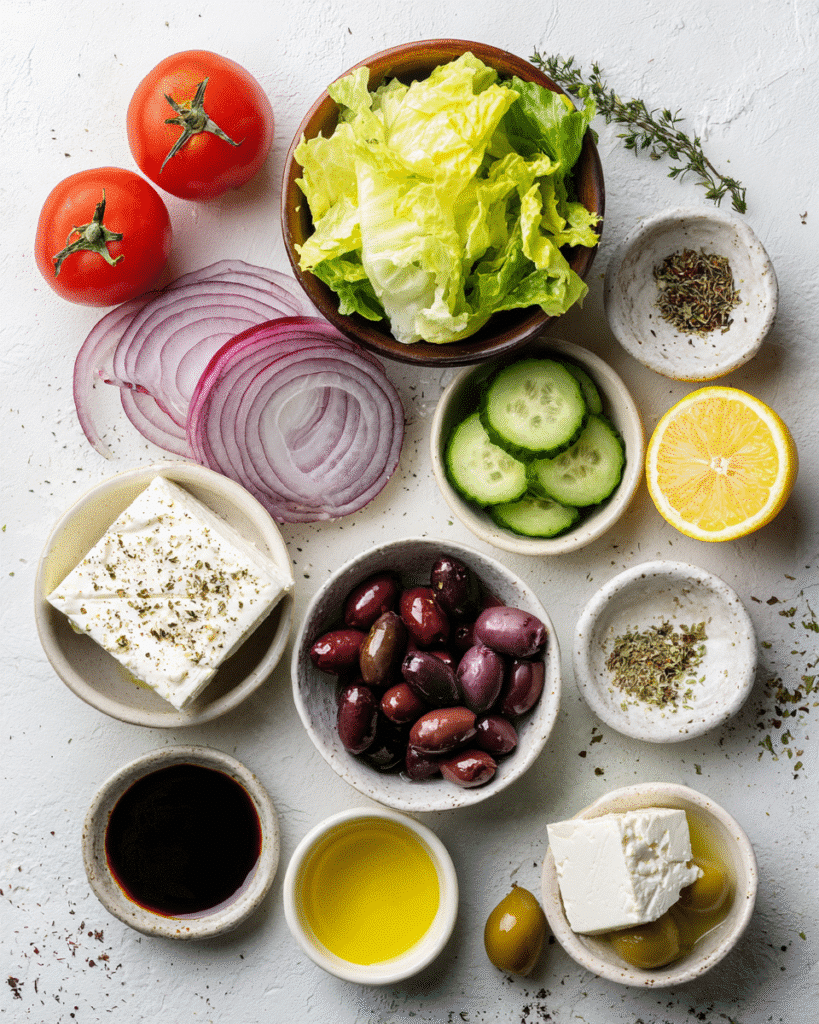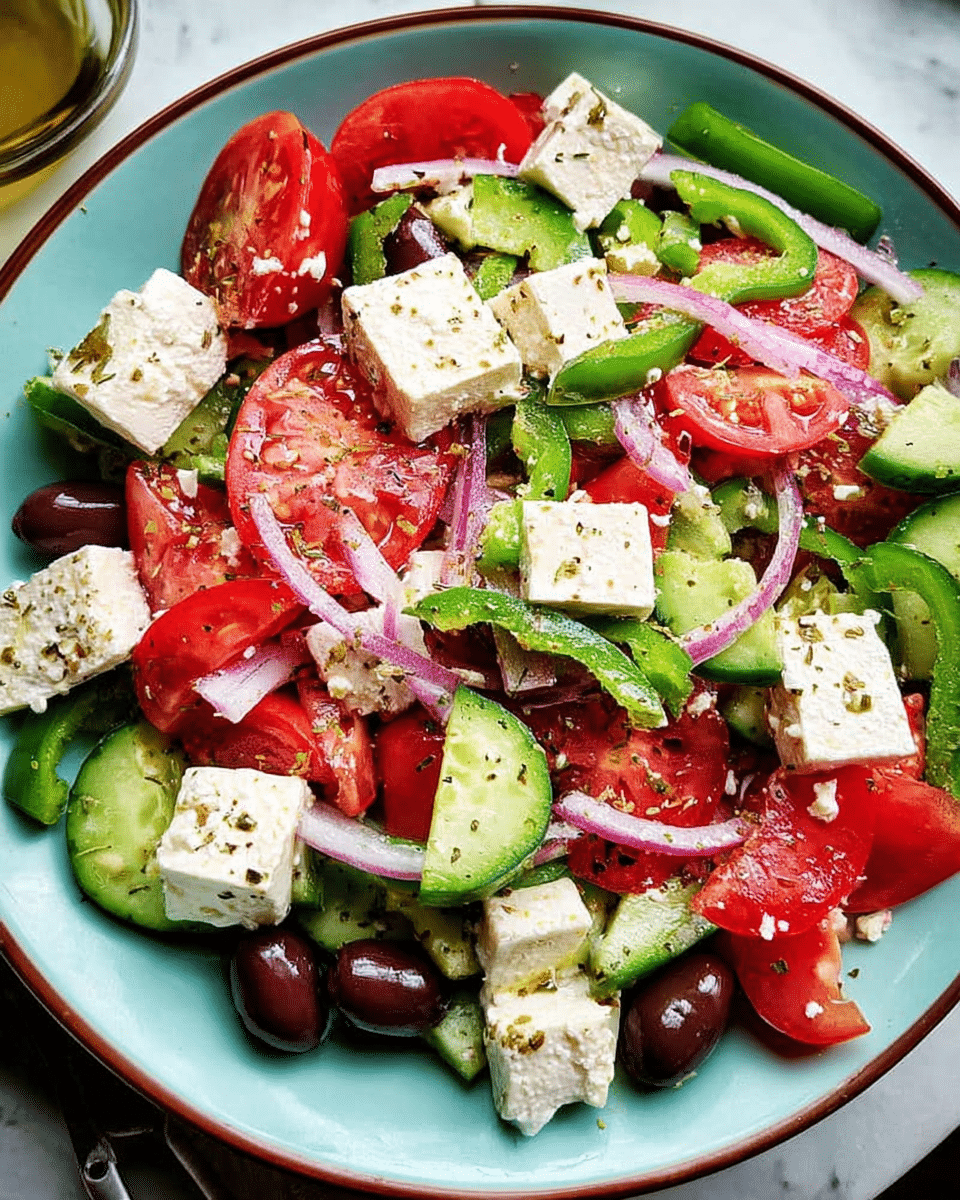Tired of bland, uninspiring salads that leave you hungry and unsatisfied? A classic Greek salad is the answer you’ve been searching for! This refreshing Mediterranean dish bursts with vibrant flavors and textures while remaining deliciously simple. Hi! I’m Emily, the creator behind Bikren Cook, and my love affair with Greek salad began during a summer trip to Santorini. The combination of sun-ripened tomatoes, crisp cucumbers, tangy feta cheese, and kalamata olives drizzled with quality olive oil changed my understanding of what a salad could be.
Over the years, I’ve perfected my authentic Greek salad recipe, focusing on ingredient quality and traditional preparation methods. In this guide, I’ll share my expertise on selecting the freshest produce, balancing flavors, and presenting this Mediterranean masterpiece for maximum impact. We’ll cover everything from ingredient selection and preparation to serving suggestions and creative variations that maintain the salad’s Greek essence.
Why This Greek Salad Recipe Works
● Uses readily available, affordable fresh vegetables
● Requires zero cooking – perfect for hot summer days
● Comes together in just 10 minutes for quick meals
● Offers the perfect balance of freshness, tanginess, and richness
● Delivers authentic Mediterranean flavors with simple ingredients
● Works as a side dish or light main course with added protein
Choosing the Right Ingredients for Greek Salad
Perfect Produce Selection
The heart of any authentic Greek salad recipe lies in the quality of its produce. For tomatoes, choose fully ripe, fragrant varieties – Roma, vine-ripened, or heirloom tomatoes offer the best flavor and texture. English or Persian cucumbers are ideal as they have fewer seeds and thinner skin than regular varieties.
The Importance of Quality Feta
Traditional Greek salad demands authentic Greek feta cheese – look for varieties made from sheep’s milk or a sheep and goat milk blend. True feta has a crumbly yet creamy texture with a tangy, salty flavor profile that perfectly complements the vegetables. Buy it in block form, not pre-crumbled, for the best texture and taste.
Olive Selection
Kalamata olives are the classic choice for an authentic Greek salad. These purple-black olives have a rich, fruity flavor and meaty texture that adds depth to the salad. Always choose pitted olives for convenience, but whole olives generally have better flavor than pre-sliced varieties.
Ingredients & Prep for Greek Salad

Fresh Vegetable Preparation
- 3 medium ripe tomatoes (cut into wedges)
- 1 large cucumber (sliced into half-moons)
- 1 medium red onion (thinly sliced)
- 1 green bell pepper (sliced into rings)
- 1/2 cup kalamata olives (pitted)
- 200g block of Greek feta cheese (cut into a single large slice or cubes)
- 1 teaspoon dried oregano
- Salt (to taste)
The Perfect Greek Dressing
- 1/4 cup extra virgin olive oil (highest quality you can afford)
- 2 tablespoons red wine vinegar
- 1 teaspoon dried oregano
- 1/2 teaspoon fresh ground black pepper
- Pinch of salt
Traditional Greek salads often skip the prepared dressing, instead relying on a generous drizzle of quality olive oil directly on the salad, but this simple dressing enhances the flavors beautifully.
Looking for other easy Mediterranean-inspired meals? Check out my One-Pan Chicken with Buttered Noodles for another quick weeknight option!
Step-by-Step Greek Salad Instructions
Vegetable Preparation for Greek Salad
Start with properly washing all produce. Cut tomatoes into wedges or chunks—the key is bite-sized pieces that retain their juiciness. Slice cucumber into half-moons about 1/4-inch thick. For authentic presentation, don’t peel the cucumber if using English or Persian varieties. Slice red onion thinly to provide flavor without overpowering the salad.
Assembling Your Greek Salad
Unlike tossed salads, a classic Greek salad is traditionally arranged, not mixed. In a wide, shallow bowl or platter, layer your ingredients starting with cucumber slices, then tomato wedges. Scatter red onion and green bell pepper slices over the top. Add kalamata olives throughout the salad.
Adding the Feta Cheese
For the most authentic Greek salad presentation, place a single large slice of feta cheese on top of the vegetables. Alternatively, you can cut the feta into large cubes and scatter throughout. Never crumble the feta finely—larger pieces provide better texture and flavor distribution.
Dressing Your Greek Salad
Whisk together olive oil, red wine vinegar, dried oregano, salt, and pepper in a small bowl. Drizzle this dressing evenly over the salad just before serving. Finish with a final sprinkle of dried oregano and a pinch of salt over the entire salad, especially on the feta cheese.
Pro Tips for Perfect Greek Salad
Quality Ingredients Make the Difference
The simplicity of Greek salad means there’s nowhere for subpar ingredients to hide. Use the highest quality extra virgin olive oil you can afford—it’s the backbone of Mediterranean cuisine. Choose vine-ripened tomatoes at the peak of ripeness and real Greek feta packed in brine for authentic flavor.
Temperature Matters
For the best flavor experience, ingredients should be at room temperature—especially the tomatoes. Cold mutes their flavor significantly. Remove your vegetables from the refrigerator at least 30 minutes before assembling. However, keep the feta cheese cool until just before serving for the best texture.
Cutting Techniques
Cut vegetables into substantial pieces rather than dicing them small. Tomato wedges, chunky cucumber slices, and rings of onion provide the rustic texture essential to authentic Greek salad. This approach also prevents the salad from becoming watery too quickly.
For more Mediterranean-inspired dishes, you’ll love my Tuscan White Bean Soup—perfect for cooler evenings!
Greek Salad Variations
Regional Greek Adaptations
Traditional Greek salad (known as “horiatiki” in Greece) varies slightly by region. Island versions might include capers, mainland variations sometimes add green peppers, and some northern regions incorporate mild peppers for subtle heat. All remain true to the essence of this refreshing Mediterranean dish.
Modern Interpretations
| Variation | Key Additions | Best For |
|---|---|---|
| Protein-Packed | Grilled chicken or shrimp | Main course salad |
| Grain-Enhanced | Cooked quinoa or farro | Hearty lunch option |
| Green Version | Added romaine or arugula | Volume without changing character |
| Watermelon Greek | Replaces some tomato with watermelon | Summer entertaining |
Dietary Adaptations
For dairy-free diets, substitute firm tofu marinated in olive oil, nutritional yeast, and herbs for a feta-like experience. For lower-sodium needs, rinse olives before adding and use less feta, focusing on quality over quantity for maximum flavor impact.
Find inspiration for delicious salad pairings on my Pinterest board where I share complementary recipes and presentation ideas that will elevate your Greek salad experience!
Serving Suggestions for Greek Salad
Greek salad shines as a versatile dish that complements many meals. Serve alongside grilled fish or chicken for a complete Mediterranean dinner. For a traditional Greek experience, pair with warm pita bread and hummus, allowing the bread to soak up the flavorful juices from the salad.
This refreshing summer salad recipe makes an impressive addition to any buffet or barbecue spread. For a complete Mediterranean feast, serve alongside lemon roasted potatoes and grilled vegetables. Greek salad also pairs beautifully with crisp white wines like Assyrtiko from Santorini or a light Pinot Grigio.
For a heartier meal option that works wonderfully with Greek salad, try my Ultimate Cheesy Ground Beef Melt for a delicious contrast of flavors!
FAQs About Greek Salad
Can I make Greek salad ahead of time?
You can prepare the components up to 4 hours ahead, but store them separately and assemble just before serving. Once dressed, the vegetables will begin to release water, affecting the texture of your salad.
How do I keep my Greek salad from getting watery?
Salt your tomatoes separately and let them drain in a colander for 15 minutes before adding to the salad. Also, dress the salad just before serving, never in advance.
Is Greek salad healthy?
Yes! This authentic Greek salad recipe is packed with fresh vegetables, heart-healthy olive oil, and protein from the feta cheese. It’s naturally gluten-free, low-carb, and full of vitamins and minerals.
What’s the difference between Greek salad and Mediterranean salad?
Greek salad specifically follows the traditional Greek recipe with tomatoes, cucumber, feta, and kalamata olives without lettuce. Mediterranean salad is a broader term that may include lettuce and various ingredients from across the Mediterranean region.
How long does Greek salad last in the refrigerator?
Once dressed, Greek salad is best consumed within 24 hours. Undressed components can be stored separately for 2-3 days.
Conclusion
Creating the perfect Greek salad isn’t just about following a recipe—it’s about understanding the philosophy behind this iconic Mediterranean dish. By focusing on ingredient quality, proper preparation, and authentic presentation, you can bring the sun-drenched flavors of Greece to your table year-round.
This refreshing salad has stood the test of time because it celebrates simple, fresh ingredients in their natural state. Whether you’re serving it as a light lunch, a side dish, or the star of your dinner table, a well-made Greek salad delivers satisfaction with every bite.
Join thousands of home cooks who have discovered the magic of this authentic Greek salad recipe! The combination of juicy tomatoes, crisp cucumber, briny kalamata olives, and creamy feta creates a harmony of flavors that’s greater than the sum of its parts. Make this Greek salad today and transport yourself to the beautiful Mediterranean coast with each delicious forkful!

